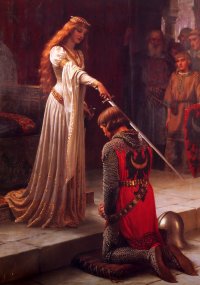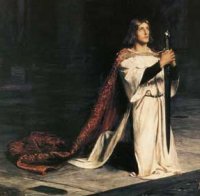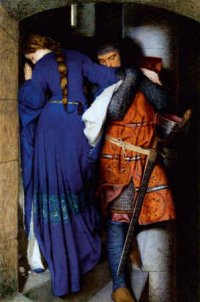|
Chivalry
[Back to Essays]
(Last revised: February 10, 2011)
[Enter the Forum]
| |

| |
The Accolade |
|
by Edmund Blair Leighton
|
|
| |
WHAT IS CHIVALRY?
I'm afraid this may be a more complex question than you think. What exactly is "chivalry"?
When someone asks you that question, your answer should not be "courtesy toward women", but
rather another question: "Which chivalry?"
You see, chivalry has undergone an evolution over the centuries, and has meant different things
to different people. To understand what chivalry really is, we need to start at the beginning
and look at the historical context of medieval knights.
The word chivalry itself derives from the French "cheval" for horse, as does the word "cavalry".
While the English word
"knight" derives from earlier words that meant "servant boy", the equivalent terms in other
languages derive from horsemanship. The German "ritter" literally means "rider", and the French
"chevalier" also derives from "cheval" like "chivalry" does.
This is no accident. When the concept of the knight was originally born, the primary distinguishing
trait is that they were mounted warriors. In fact, all that was needed in order to be considered
a knight was to have the equipment (weapons, armor, and horses) and the know-how to use them.
Young able-bodied males of sufficient wealth were expected to train in the use of arms and
horsemanship, and would be called a knight. Over the years, the title of "knight" and the overall
concept of knighthood would gradually become more formalized, until it became a title of minor
nobility rather than a generic term for mounted warriors.
During these earlier years, however, knights could be an unruly bunch. History is filled
with great triumphs but also heinous injustices and atrocities. Chivalry was developed as a
code of conduct amongst this warrior class, to dictate how they should behave both on and
off the battlefield. But it did not concern women, for it applied only to how knights should
treat one another, and those above their station. Nor was it a rigid code of rules, with
specific goals. Any such written codes are more modern attempts to explicitly codify rules
that didn't exist in such a formalized manner. No, it was merely a general sense of
honorable behavior amongst the knights themselves and how they acted in the
presence of nobility.
| |

| |
The Vigil |
|
by John Pettie
|
|
| |
This level of chivalry included honor, duty, prowess (a combination of strength and courage,
and a stick-to-it attitude to get things done), and largesse (not necessarily giving to
the poor, as that would be "charity", but rather sharing your wealth with your friends,
peers, and your lord). Knights were not expected to treat the commoners well. Rather, there
was a sense that they could be above penny-pinching, and should be more concerned with
tangible or practical matters. They needed to have an understanding of what needed to be done,
and an ability to do it.
By the time that knighthood had evolved into a title of nobility, rather than being
equestrian warriors, chivalry had been adapted to courtly behavior, as a form of
proper and dignified behaviour amongst peers. Courtesy, respect, and good manners, to those
who deserve it, as defined by the social structure of the time.
This is a very different matter than being strong and brave in battle, and to some degree the
origin of the "treat women well" sentiment.
After the relevant period in history had faded away, there was a revival of interest in
the medieval period during the nineteenth century. Many self-styled Victorian-era
"scholars" during this time made poor interpretations of medieval and renaissance literature,
and filled in the gaps with their own imagination. Many fictional stories were written during
this time as well. Most of the misconceptions that were created during this time are still
with us, such as the notion that armored knights needed to be lifted into their saddle with a
crane, or that they could not run in armor, or that the armor would prevent them from getting
back up should they be knocked over. Just as the Victorians had decided that swords weighed
upward of twenty pounds, so too did they give us the rose-tinted view that chvialry was
all about treating women well, and that knights were always honorable and charitable to everyone.
Most of the "common knowledge" that still circulates in society today came from misconceptions
that were perpetrated by the Victorians.
| |

| |
The Meeting on Turret Stairs |
|
by Frederick William Burton
|
|
| |
So when speaking of historical chivalry, I think we can break it down into three flavors:
- Medieval Chivalry, the warrior ethos.
- Renaissance Chivalry, courtly conduct.
- Victorian Chivalry, kindness to women and general courtesy.
This is a bit over-simplified of course.
Perhaps we can add a fourth flavor, modern chivalry. Today there are many who feel that
chivalry is just as important now as it has been throughout the last millenium. It must
be adapted to modern times, just as it evolved for each era in the past.
There are also many historical enthusiasts who study knights, armor, and swordsmanship,
who consider chivalry to be an important part of their studies. Any martial art needs
to be tempered with honor, restraint, and wisdom. Chivalry can be adapted here as well.
So perhaps, as a modern form of chivalry, we should take all of the best virtues that
history has provided for us, adapt them for the modern day, and apply them as we can.
After all, who would want to live in a society where virtues such as honor, courage,
honesty, courtesy, and respect are dismissed as archaic and unnecessary?
|